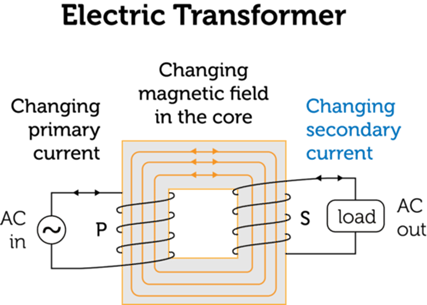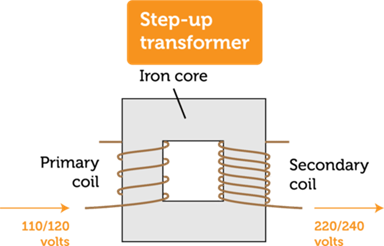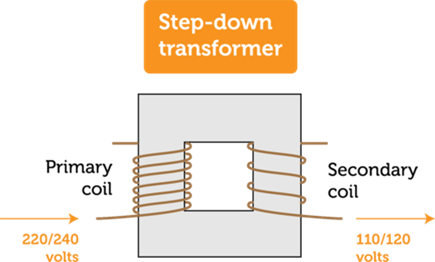Mutual induction and Transformers
Transformers

[Figure 1]
You’ve probably noticed big drums like this one at the tops of electric poles. A pole close to your home is likely to have one. The drum is an electric transformer. Without it, the current entering your home would have too much voltage for your home’s electric circuits to handle.
What Is an Electric Transformer?
An electric transformer is a device that uses electromagnetic induction to change the voltage of electric current. Electromagnetic induction is the process of generating current with a magnetic field. It occurs when a magnetic field and electric conductor, such as a coil of wire, move relative to one another. A transformer may either increase or decrease voltage. You can see the basic components of an electric transformer in the Figure below.

[Figure 2]
The transformer in the diagram consists of two wire coils wrapped around an iron core. Each coil is part of a different circuit. When alternating current passes through coil P, it magnetizes the iron core. Because the current is alternating, the magnetic field of the iron core keeps reversing. This is where electromagnetic induction comes in. The changing magnetic field induces alternating current in coil S of the other circuit.
Stepping Up or Stepping Down
Notice that coil P and coil S in the Figure above have the same number of turns of wire. In this case, the voltages of the primary and secondary currents are the same. Usually, the two coils of a transformer have different numbers of turns. In that case, the voltages of the two currents are different.
· When coil S has more turns than coil P, the voltage in the secondary current is greater than the voltage in the primary current (see Figure below). This type of transformer is called a step-up transformer. That’s because it steps up, or increases, the voltage.

[Figure 3]
· When coil S has fewer turns of wire than coil P, the voltage in the secondary current is less than the voltage in the primary current (see Figure below). This type of transformer is called a step-down transformer because it steps down, or decreases, the voltage.

[Figure 4]
Q: Both step-up and step-down transformers are used in the electrical grid that carries electricity from a power plant to your home. Where in the grid do you think step-down transformers might be used?
A: One place that step-down transformers are used is on the electric poles that supply current to homes. They reduce the voltage of the electric current before it enters home circuits.
Launch the AC Transformer simulation below to visualize how we use a transformer to “step down” the high voltage on a residential power line:
Summary
· An electric transformer is a device that uses electromagnetic induction to change the voltage of an electric current.
· A step-up transformer increases voltage. A step-down transformer decreases voltage.
Review
1. What is an electric transformer?
2. How does an electric transformer use electromagnetic induction?
3. Compare and contrast step-up and step-down transformers.
https://flexbooks.ck12.org/cbook/ck-12-middle-school-physical-science-flexbook-2.0/section/22.8/primary/lesson/electric-transformers-ms-ps/